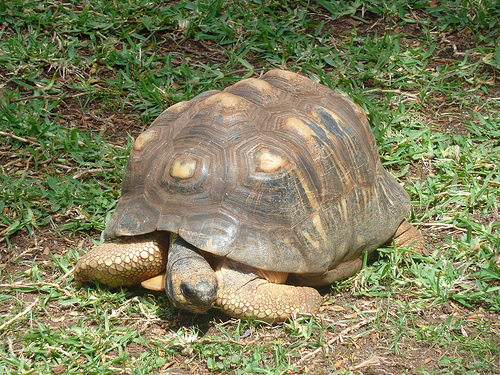Admire the beauty of radiated tortoises.
- Radiated tortoises, sometimes called ‘sokake’, are reptiles native to the southern areas of Africa’s island of Madagascar.
- The scientific name of a radiated tortoise is Astrochelys radiata, and is from the family Testudinidae, the family of tortoises.
- The diet of radiated tortoises consists primarily of grass, but fruit and cacti and other plants are also consumed.
- Radiated tortoises can grow to be 30 to 41 centimetres (12 to 16 inches) in length, and weigh 2.2 to 16 kilograms (4.8 to 35 pounds).
- The humped shell of a radiated tortoise is generally a dark brown or black colour, that is patterned with prominent yellow coloured star-like shapes.
Radiated Tortoise
Image courtesy of Paul Morris/Flickr
- Female radiated tortoises lay and deposit eggs in holes that they dig, numbering 3 to 12 eggs at a time, and they leave them to incubate and hatch 4 to 8 months later.
- Radiated tortoises have a mostly yellow coloured head and legs; and on average, they live for 30 to 90 years, although one has been recorded to live to around 188 years old.
- While radiated tortoises are protected, they are ranked as critically endangered, due to habitat loss and illegal hunting for the shell, meat and pet industry.
- Radiated tortoises can produce grunting and hissing noises, as well as screeching sounds to scare off predators.
- Radiated tortoises are preyed on by snakes and large birds, and they can protect themselves to some extent by withdrawing into their shell.
Bibliography:
Radiated Tortoise, 2013, A-Z Animals, http://a-z-animals.com/animals/radiated-tortoise/
Radiated Tortoise, 2015, Wikipedia, http://en.wikipedia.org/wiki/Radiated_tortoise








